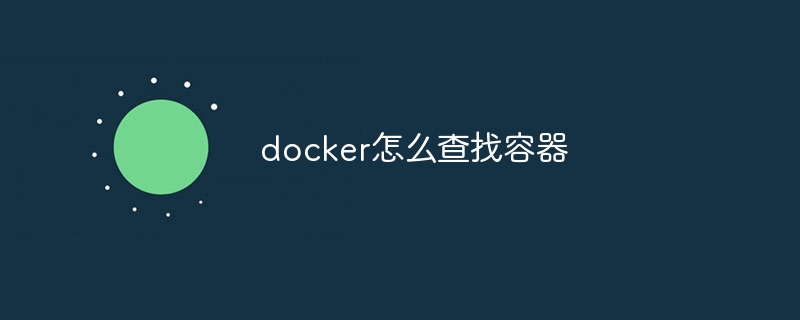How to find containers for docker
You can use a variety of methods provided by Docker to find containers, including: Docker CLI: Use commands such as docker ps to list containers and use filters to narrow down searches. Docker API: Send a request to retrieve container information. Docker Compose: Use commands such as docker-compose ps to list containers. Docker Tools: Use tools such as Docker Explorer or Portainer to manage containers in a graphical interface. Container ID: Use a unique ID to find containers with the Docker CLI, API, or tool.

How to find a Docker container
Docker provides multiple ways to find and filter containers. Here are some commonly used methods:
1. Find containers using the Docker CLI
<code class="bash"># 列出所有容器docker ps # 过滤容器列表docker ps -a # 列出所有容器,包括已停止的容器docker ps --filter "name=my-container" # 过滤名称为"my-container" 的容器</code>
2. Use the Docker API to find containers
<code class="bash"># 使用curl 发送请求curl -X GET -H "Content-Type: application/json" http://localhost:2375/containers/json</code>
3. Find containers using Docker Compose
<code class="bash"># 列出所有容器docker-compose ps # 过滤容器列表docker-compose ps --filter "name=my-container" # 过滤名称为"my-container" 的容器</code>
4. Use Docker tools to find containers
- Docker Explorer: A graphical interface that allows you to browse and manage Docker containers.
- Portainer: An open source container management platform that provides a graphical interface to manage containers.
5. Find containers using Docker container ID
Each container is assigned a unique ID. You can use this ID to find containers with the Docker CLI, API, or tools.
<code class="bash"># 使用Docker CLI docker inspect <container-id></container-id></code>
hint:
- Use the
-for--filteroption to filter the container list to narrow the search. - You can also use the
docker inspectcommand to view detailed information about a specific container, including its ID, name, image, and other metadata.
The above is the detailed content of How to find containers for docker. For more information, please follow other related articles on the PHP Chinese website!

Hot AI Tools

Undresser.AI Undress
AI-powered app for creating realistic nude photos

AI Clothes Remover
Online AI tool for removing clothes from photos.

Undress AI Tool
Undress images for free

Clothoff.io
AI clothes remover

Video Face Swap
Swap faces in any video effortlessly with our completely free AI face swap tool!

Hot Article

Hot Tools

Notepad++7.3.1
Easy-to-use and free code editor

SublimeText3 Chinese version
Chinese version, very easy to use

Zend Studio 13.0.1
Powerful PHP integrated development environment

Dreamweaver CS6
Visual web development tools

SublimeText3 Mac version
God-level code editing software (SublimeText3)

Hot Topics
 How to exit the container by docker
Apr 15, 2025 pm 12:15 PM
How to exit the container by docker
Apr 15, 2025 pm 12:15 PM
Four ways to exit Docker container: Use Ctrl D in the container terminal Enter exit command in the container terminal Use docker stop <container_name> Command Use docker kill <container_name> command in the host terminal (force exit)
 How to check the name of the docker container
Apr 15, 2025 pm 12:21 PM
How to check the name of the docker container
Apr 15, 2025 pm 12:21 PM
You can query the Docker container name by following the steps: List all containers (docker ps). Filter the container list (using the grep command). Gets the container name (located in the "NAMES" column).
 How to copy files in docker to outside
Apr 15, 2025 pm 12:12 PM
How to copy files in docker to outside
Apr 15, 2025 pm 12:12 PM
Methods for copying files to external hosts in Docker: Use the docker cp command: Execute docker cp [Options] <Container Path> <Host Path>. Using data volumes: Create a directory on the host, and use the -v parameter to mount the directory into the container when creating the container to achieve bidirectional file synchronization.
 How to restart docker
Apr 15, 2025 pm 12:06 PM
How to restart docker
Apr 15, 2025 pm 12:06 PM
How to restart the Docker container: get the container ID (docker ps); stop the container (docker stop <container_id>); start the container (docker start <container_id>); verify that the restart is successful (docker ps). Other methods: Docker Compose (docker-compose restart) or Docker API (see Docker documentation).
 How to start mysql by docker
Apr 15, 2025 pm 12:09 PM
How to start mysql by docker
Apr 15, 2025 pm 12:09 PM
The process of starting MySQL in Docker consists of the following steps: Pull the MySQL image to create and start the container, set the root user password, and map the port verification connection Create the database and the user grants all permissions to the database
 How to update the image of docker
Apr 15, 2025 pm 12:03 PM
How to update the image of docker
Apr 15, 2025 pm 12:03 PM
The steps to update a Docker image are as follows: Pull the latest image tag New image Delete the old image for a specific tag (optional) Restart the container (if needed)
 How to start containers by docker
Apr 15, 2025 pm 12:27 PM
How to start containers by docker
Apr 15, 2025 pm 12:27 PM
Docker container startup steps: Pull the container image: Run "docker pull [mirror name]". Create a container: Use "docker create [options] [mirror name] [commands and parameters]". Start the container: Execute "docker start [Container name or ID]". Check container status: Verify that the container is running with "docker ps".
 How to create containers for docker
Apr 15, 2025 pm 12:18 PM
How to create containers for docker
Apr 15, 2025 pm 12:18 PM
Create a container in Docker: 1. Pull the image: docker pull [mirror name] 2. Create a container: docker run [Options] [mirror name] [Command] 3. Start the container: docker start [Container name]






